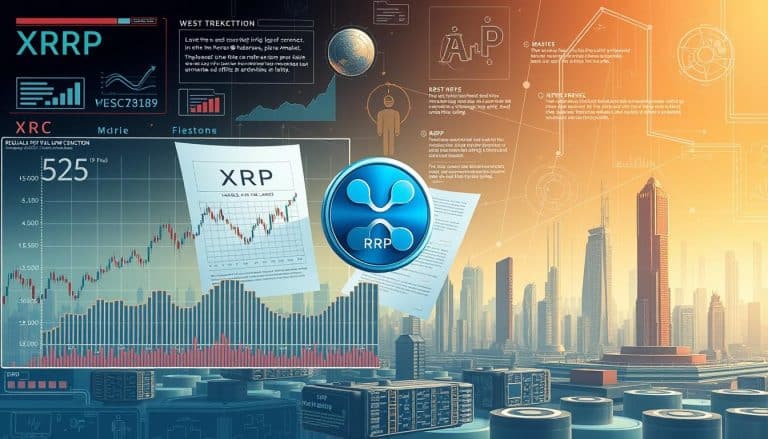Xrp Partnerships And Long-Term Prospects
XRP is like a digital currency on an ever-expanding journey, and each new partnership brings it closer to its destination. As the world’s third largest cryptocurrency by market capitalization, it has become increasingly popular with investors looking for long-term returns. In this article, we will explore the technology that underpins XRP, the advantages and challenges of investing in it, partnerships that have been established, strategies for investing and trading it, tax implications of owning XRP, as well as security considerations.
Overview of XRP
XRP is a digital asset and blockchain-based payments platform that enables financial institutions to rapidly move funds across borders with drastically reduced transaction costs; for example, in 2017, Santander Bank used XRP technology to facilitate international money transfers in seconds. The technology behind XRP is based on its distributed ledger system known as the XRP Ledger, which allows users to transact quickly and securely without requiring a third party intermediary. It also supports various use cases such as cross-border payments, settling trades on exchanges, and providing liquidity in real time. Moreover, it facilitates easy integration of existing banking infrastructure into the blockchain ecosystem by providing an open source API for developers. This enables banks to leverage the benefits of distributed ledger technology while still maintaining their current systems in place. As such, XRP has shown promise as a viable solution for many financial institutions looking to reduce costs and improve efficiency when making global transactions. With its wide range of potential applications and collaborations with major financial institutions already underway, XRP stands out as an attractive investment option with long-term prospects.
Technology Behind XRP
RippleNet is a network of institutional payment-providers that use Ripple’s solutions to provide customers with enhanced speed, transparency and lower cost payments. XRP Ledger is an open source digital ledger technology based on distributed consensus which powers XRP. Interledger Protocol (ILP) enables transactions across different ledgers, allowing for the efficient transfer of value between different networks. Together these three technologies form the backbone of Ripple’s cross-border payments system and provide the basis for its global reach.
RippleNet
RippleNet, the global payments network developed by Ripple, is a growing cross-border payments solution that facilitates real-time settlement of transactions. It utilizes innovative technologies such as blockchain and Interledger protocols to streamline payments across different networks. RippleNet’s scalability makes it suitable for large corporate clients and financial institutions. Additionally, its usage of Interledger Protocol allows users to send money from any currency to any other currency with minimal fees and high security.
The architecture behind RippleNet enables it to be used for various solutions including xRapid, xVia, and xCurrent helping businesses get connected with one another in order to facilitate quick payment transfers across borders while reducing costs associated with liquidity and settlement times. Through these services, RippleNet has become an attractive option for banks and financial institutions around the world seeking cost-effective ways to transfer funds quickly between countries or currencies. As RippleNet continues to grow exponentially over time, its potential use cases will become increasingly vast. With this in mind, XRP Ledger is positioned as the ideal platform for applications built on top of it due its speed and low cost of transaction fees.
XRP Ledger
The XRP Ledger is a distributed ledger technology developed by Ripple to support its suite of payment solutions, providing a foundation for applications that enable real-time settlement and money transfers. The platform uses a consensus mechanism in which validators join the network and are incentivized with staking rewards for verifying transactions. It also enables users to trade digital assets on decentralized exchanges, allowing them to access new markets without centralized intermediaries.
The XRP Ledger is powered by the Interledger Protocol (ILP), which provides an open source protocol for connecting different ledgers and networks together. This allows payments to be sent across different currencies and jurisdictions without the need for multiple parties, thus enabling faster payments at lower cost. ILP also offers scalability and security benefits as it does not rely on any single ledger or node for processing transactions.
Interledger Protocol
The Interledger Protocol (ILP) provides an open source solution for connecting different ledgers and networks, allowing for faster payments at reduced cost without the need for multiple parties. ILP is a suite of protocols designed to enable interoperability between different ledger systems. It consists of four layers: Connectors, Ledger Adapters, Interledger Protocols and Payments. The Connector layer enables users to connect their wallets to other wallets or ledgers, while the Ledger Adapter layer facilitates communication between different ledger types. The Interledger Protocol layer provides the logic used by connectors to route payments across different ledgers, while the Payment layer handles payment processing on top of that logic.
The use cases enabled by this protocol include cross-border payments, micro-payments and micropayment streaming services such as video streaming and gaming. Additionally, it provides infrastructure for decentralized exchanges powered by smart contracts on distributed ledgers. These features make it an attractive option for companies looking to facilitate real-time payments in various currencies worldwide with minimal cost and risk involved.
| Use Cases | Infrastructure |
|---|---|
| Cross-border Payments | Connector Layer |
| Micro & Micropayments | Ledger Adapter Layer |
| Video Streaming & Gaming | Interledger Protocol Layer |
| Decentralized Exchanges | Payment Layer |
ILP offers significant advantages over existing payment solutions due its scalability, low transaction costs and fast settlement times; making it an ideal technology for creating secure financial applications with global reach. Moving forward, XRP’s partnership with the ILP will undoubtedly bolster its ability to expand its platform even further into new markets and industries around the world.
Advantages of XRP
XRP has the advantage of providing fast, low-cost, and reliable cross-border payments to its users. XRP transactions are settled in four seconds compared to traditional payment systems that can take up to several days. This makes it more attractive than other currencies for cross-border payments since it eliminates delays due to intermediaries. Additionally, XRP is cheaper than other digital payment solutions such as Bitcoin and Ethereum due to its superior scalability. It is estimated that an XRP transaction costs only 0.00001 XRP compared to Bitcoin’s average fee of $3-$4 USD per transaction. The scalability issues associated with the Bitcoin blockchain make it difficult for merchants and consumers alike who need faster transactions which makes them look towards alternative solutions like Ripple’s XRP token as a solution. With these advantages, XRP has become a popular choice for cross-border payments by many companies and organizations around the world. However, there are still some challenges that need to be addressed before widespread adoption can occur.
Challenges of XRP
Despite its advantages, the adoption of XRP is hindered by a number of challenges that need to be addressed. Price volatility and liquidity issues are two primary obstacles to XRP’s success. As an asset class, price volatility can negatively affect investor confidence and make it difficult for investors to trust a digital currency with their funds. Additionally, since there is no central issuer of XRP and it is not backed by any government or institution, liquidity issues can arise when investors want to convert their holdings into cash or other assets. These factors present significant challenges for the long term prospects and partnerships of XRP as they could prevent institutional investors from investing in the cryptocurrency and limit its mainstream appeal. Therefore, finding solutions to these issues will be essential for XRP’s success in terms of partnerships and long-term prospects. Moreover, this highlights the importance of ongoing research in order to find ways to maximize the potential of XRP as an asset class.
XRP’s Partnerships
XRP has been facing several challenges in the recent past. One of these is the need to secure strategic partnerships with prospective partners that can help it reach its long-term goal of becoming a major player in the global financial markets. To this end, XRP has been actively engaging in strategic alliances with several entities to strengthen its competitive advantage and broaden its reach. These partnerships have included collaborations with banks, payment providers, and other cryptocurrency companies such as RippleNet, MoneyGram, American Express, Santander Bank, Payment Rails and SBI Holdings. Each of these alliances bring significant benefits to XRP by increasing user adoption and providing exposure to new potential customers that could eventually lead to increased revenues for the company. The aim is for XRP to establish itself as a leading digital currency through these strategic relationships which will ultimately improve its long-term prospects.
With successful partnerships already formed or underway with numerous financial institutions worldwide, XRP is now turning its attention towards regulatory matters in order to ensure compliance within different jurisdictions. This move could prove beneficial for both XRP’s short-term operations as well as its longer-term prospects for growth and stability in the market.
XRP’s Regulatory Status
In order to ensure its longevity in the global financial landscape, XRP has taken steps to secure regulatory compliance in different jurisdictions. In order to do this, the company has worked closely with regional and international regulators to ensure that its cryptocurrency regulations comply with existing laws. Specifically, XRP is registered as a money services business (MSB) in the United States and holds an e-money license from the UK’s Financial Conduct Authority (FCA). This strategy of engaging with government bodies allows XRP to remain cognizant of any new laws or regulations that may affect cryptocurrencies and make necessary adjustments. As a result, XRP can continue offering its services while still abiding by applicable laws. To further solidify its relationship with regulators, XRP also established RippleNet Regulatory Clarity, which provides resources for legal teams around the world who are seeking clarification about local laws related to blockchain technology. With these measures in place, XRP is well-positioned to maintain sound regulatory compliance as it continues its expansion into other markets. By ensuring regulatory compliance, XRP has put itself on a path towards long-term success and sustainability.
XRP’s Long-Term Prospects
Rising to the forefront of the cryptocurrency market, XRP has positioned itself for tremendous long-term growth that could go absolutely exponential. Market speculation and predicting trends from a technical, analytical point of view are key factors in determining XRP’s potential success over time. To this end, there are several notable indicators that should be taken into consideration when assessing XRP’s long-term prospects:
- Potential partnerships with major corporations or financial institutions;
- The ability to scale quickly and effectively;
- The strong backing of Ripple Inc;
- An active development team working on continual improvements.
These factors combined make it clear that XRP is well-positioned for a promising future. With that said, its ultimate long-term performance will depend on how well these features can be leveraged and capitalized on in the cryptocurrency ecosystem. As such, an examination of its historical price performance can provide more insight into its trajectory going forward.
XRP’s Price Performance
The history of XRP’s price performance illuminates its potential for future growth in the cryptocurrency market. Since its inception, XRP has been characterized by marked volatility and wide fluctuations in price due to limited liquidity. This has resulted in investments that are inherently risky but also offer potentially high rewards. Despite these risks, XRP has proven itself to be a reliable medium of exchange since its launch and over time it may become more stable as its liquidity increases. Consequently, XRP presents an opportunity for investors who can tolerate some degree of risk and are willing to wait for long-term returns on their investment. Nevertheless, the risks associated with investing in XRP should not be overlooked as they could result in significant financial losses. As such, it is important for investors to understand both the advantages and drawbacks before making any decisions regarding their investment options. With this knowledge, investors can make informed decisions about how best to balance potential reward with risk when considering an investment in XRP.
Risks of Investing in XRP
Investing in XRP carries a certain degree of risk due to its inherent volatility and limited liquidity. Ripple adoption entails various risks, including regulatory considerations, technology risk, and market forces. For instance, the lack of regulations in the digital asset space increases uncertainty among investors who are unsure if their investments will be protected by existing laws. Furthermore, technology risk refers to the possibility that Ripple’s distributed ledger technology could become obsolete or compromised due to cyber-attacks or other events. Finally, markets can be unpredictable and volatile; any major changes in sentiment towards XRP could have drastic consequences for prices.
Despite these risks associated with investing in XRP, there are also potential benefits to consider before making an investment decision. Moreover, these benefits need to be weighed against the potential risks when considering an investment in XRP. Consequently, it is important for investors to understand both sides of the equation before deciding whether or not to invest in XRP.
Benefits of Investing in XRP
Given its relatively low cost and fast transaction speeds, investing in XRP can be compared to a journey with a well-mapped route: it may take some time to get there, but the destination is certain. With its distributed ledger technology, XRP is able to process transactions faster than other crypto currencies. This makes it an attractive proposition for those wanting to send money across borders quickly and securely. Additionally, since XRP is classified as a utility token rather than a security token, it does not come with the same regulatory scrutiny as other crypto currencies. This means that investors are free from the risks associated with investing in securities without sacrificing liquidity or stability. In particular, this benefit is particularly beneficial for banks and financial institutions looking for ways to integrate blockchain technology into their operations without having to comply with stringent regulations. All of these features make XRP an appealing choice for those interested in investing in cryptocurrency and taking advantage of the potential benefits associated with crypto banking. As such, investors should consider carefully whether they would like to invest in XRP before making any decisions. By doing so, they can ensure that their investment will be secure and profitable over the long term. Transitioning into strategies for investing in XRP should involve careful consideration of risk tolerance levels as well as research into market movements and trends within the cryptocurrency space to ensure that investments are made wisely.
Strategies for Investing in XRP
The benefits of investing in XRP can potentially be lucrative, but investors must consider the potential risks involved. To minimize risk and maximize return, investors should develop a comprehensive investment strategy for their XRP holdings. Crypto economics provides guidance on how to best approach investments in digital assets like XRP. The adoption trends of cryptocurrency and blockchain technologies provide insight into which strategies have been successful in the past and which may be more suitable for the future. It is essential to understand that investing in XRP is speculative and highly volatile, so it is important to create a portfolio diversification strategy that takes into account both short-term trading opportunities as well as long-term growth prospects. By utilizing market analysis tools as well as monitoring adoption trends, investors can make informed decisions about when to buy or sell XRP.
Strategies for Trading XRP
By monitoring cryptocurrency movements and leveraging market analysis tools, traders can identify short-term trading opportunities for XRP. To gain an advantage over the competition, traders must be able to assess current conditions in the market and understand basic principles of trading psychology. A successful XRP trader should have a grasp on: (1) utilizing technical indicators to recognize patterns; (2) assessing fundamentals such as news events and corporate announcements; (3) understanding the difference between long-term and short-term strategies. With these skills, a trader can maximize their probability of success when trading XRP.
To successfully navigate potential pitfalls in trading XRP, it is also important to be aware of tax implications that come with investing in cryptocurrencies. This requires understanding how different countries tax digital assets and what regulations are currently in place. Taking these considerations into account will ensure that profits from XRP trading are realized without unexpected surprises at tax time.
Tax Implications of Investing in XRP
Navigating the complex taxation landscape of cryptocurrencies is essential for any XRP investor to maximize their potential gains. Depending on the jurisdiction, XRP investors may be subject to capital gains taxes or tax credits which can provide significant tax incentives if they are in compliance with local laws. In addition, there are also potential compliance costs associated with filing taxes related to XRP investments as regulations can vary greatly from country to country. As such, it is important for XRP investors to consider the relevant tax implications when making decisions about investing in this digital asset. By understanding these factors and taking into account the security considerations of investing in XRP, investors can make informed decisions that will help them reach their desired investment goals.
Security Considerations
Investing in XRP requires thorough consideration of the security risks associated with this digital asset and its underlying technology. Cryptographic security is essential to ensure that transactions are secure, private, and authenticated. This means that users must trust the cryptographic algorithms used to protect their assets from potential attackers. Additionally, blockchain security is critical for protecting user funds from malicious actors who may attempt to steal or manipulate data on the ledger.
To ensure security when investing in XRP, investors should: 1) Familiarize themselves with the different types of cryptographic algorithms used in the platform; 2) Know how their funds are stored and protected by the network; 3) Monitor any ongoing developments related to blockchain security; 4) Take measures to protect their own device(s). By taking these steps, investors can reduce their exposure to potential threats and increase their confidence when investing in XRP.
Frequently Asked Questions
What is the minimum amount of XRP needed for investing?
The minimum amount of XRP needed for investing depends on the individual’s investment strategies and liquidity concerns. Factors such as risk tolerance, time horizon, and financial objectives should be taken into account when determining the appropriate amount.
How does XRP compare to other cryptocurrencies?
XRP has seen high price volatility compared to other cryptocurrencies, but its fast transaction speed may be appealing for investors. Comparatively, XRP is much faster than Bitcoin and Ethereum while having a lower transaction fee.
What are the steps for setting up an XRP wallet?
XRP is the third-largest cryptocurrency by market capitalization with a security system that has never been breached. Setting up an XRP wallet requires downloading and installing a wallet application, creating an account with secure credentials, and activating two-factor authentication to ensure wallet security.
Is there a limit to XRP’s total supply?
XRP has a total supply limit of 100 billion coins. This limit was established by the Ripple company, though it is subject to legal implications due to its collaboration opportunities with other entities.
What is the process for buying and selling XRP?
XRP can be purchased and sold via marketplaces, with liquidity management strategies employed to ensure efficient transactions. Marketing strategies are used to increase the visibility of XRP, driving demand and creating a competitive environment for buyers and sellers.





 Bitcoin
Bitcoin  Ethereum
Ethereum  Tether
Tether  XRP
XRP  USDC
USDC  Solana
Solana  TRON
TRON  Lido Staked Ether
Lido Staked Ether  Dogecoin
Dogecoin  Figure Heloc
Figure Heloc  Cardano
Cardano  WhiteBIT Coin
WhiteBIT Coin  Wrapped stETH
Wrapped stETH  Bitcoin Cash
Bitcoin Cash  Wrapped Bitcoin
Wrapped Bitcoin  USDS
USDS  Wrapped eETH
Wrapped eETH  Binance Bridged USDT (BNB Smart Chain)
Binance Bridged USDT (BNB Smart Chain)  Chainlink
Chainlink  Monero
Monero  LEO Token
LEO Token  WETH
WETH  Zcash
Zcash  Stellar
Stellar  Hyperliquid
Hyperliquid  Coinbase Wrapped BTC
Coinbase Wrapped BTC  Ethena USDe
Ethena USDe  Litecoin
Litecoin  Sui
Sui  Avalanche
Avalanche  Hedera
Hedera  sUSDS
sUSDS  USDT0
USDT0  Shiba Inu
Shiba Inu  Dai
Dai  PayPal USD
PayPal USD  Uniswap
Uniswap  Mantle
Mantle  Cronos
Cronos  World Liberty Financial
World Liberty Financial  Toncoin
Toncoin  Canton
Canton  Ethena Staked USDe
Ethena Staked USDe  Polkadot
Polkadot  USD1
USD1  Rain
Rain  MemeCore
MemeCore  Aave
Aave